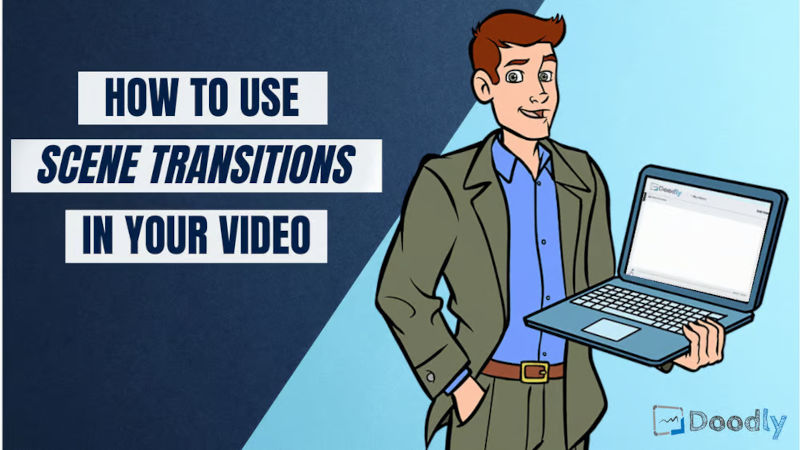Free
Doodly Scene Transitions
Welcome to today’s blog where we’ll dive into scene transitions in Doodly and explore the best objects to use for each transition.
Scene transitions are video effects that smoothly transition from one scene to the next, maintaining the flow of your video. In Doodly, you can find transition settings in two locations: Video Settings and Scene Settings.
By default, your video is set with a swipe-left transition, but you have the option to change it. You can use JPEG, PNG, SVG, or even GIF files to add more animation to your scenes.
Let’s start by exploring the different types of scene transitions found in Video Settings.
1. None:
This is a seamless transition with no effect. Ideal for professional presentations or videos where you want a clean, quick scene transition.
2. Swipe left:
The original scene swipes to the left, revealing a blank slate or instantly appearing assets. Perfect for showcasing moving objects like cars or animals.
3. Swipe right:
Similar to swipe left, but the scene swipes to the right. Great for depictions of running or movement.
Now, let’s see these transitions in action with some sample objects.
For example, in a business deck presentation, we used Doodly to create animated scenes. We added a dog on a leash, a pet bowl, and a dog house. The transition is set to “None”, resulting in a smooth and clean scene change.
In another example, we created a comic skit using the “None” transition. The scene enters with a soft fade in motion, achieved by adjusting the reveal mode and animation duration.
To showcase a moving car, we imported a GIF file and applied the swipe-left effect. We adjusted the scene duration to ensure the car had enough time to move before the transition took effect.
We also used swipe left for a cute skating dog and swipe right for runners competing with each other. The transitions bring these scenes to life.
In addition, we can use swipe right to display a moving arrow. By maximizing the image to cover the entire scene, we created an animated effect.
Remember, matching the background color to the image you’re using enhances the overall visual impact. You can customize the background color using the scene setting’s background style menu or upload a custom image.
4. Swipe Up
Swipe up is a transition where the original scene swipes upwards, revealing a blank slate or any assets you’ve chosen to appear instantly. This transition is perfect for objects that are meant to move up, like balloons.
In this example, we have imported two hot air balloons. For the first image, we disabled the hand drawing and set the reveal mode to Fade. For the second balloon, we have the reveal mode set to Draw.
Let’s take a look at another example. We used balloons, a classic object that goes up, which we often see at birthday parties. Balloons make great objects to use for our swipe-up transition.
And of course, look up in the sky! It’s a bird, it’s a plane… it’s Superman! Superman looks amazing in a swipe-up transition.
5. Swipe Down
Our next transition is swipe-down, the opposite of swipe-up. With swipe-down, the original scene swipes downward, revealing a blank slate or your next set of assets.
If your video includes a character that is falling, a swipe-down transition will make it look like your character is actually falling. You can get creative with the following scenes by adding other falling objects, making it a hit.
In this example, we have a GIF file of a flaming meteor rock, and it is falling.
Lastly, a diver diving off with bubbles around her looks great in a swipe-down transition. For this example, we used a PNG file for the diver and uploaded the bubbles separately as a GIF file.
6. Swap Mixed
Choosing the swap mixed transition applies a random mix of transitions to your presentation. You can have a combination of swipe left, swipe right, swipe up, and swipe down.
7. Camera Panning
With the camera panning transition, the camera moves to a blank section of the whiteboard, where you can see a portion of the original drawing in the new scene. When using this option, be mindful of how you place your assets, as you may not like which portions are shown. Note that this setting can only be applied in the video sections of Doodly.
To make an asset appear in the next scene when the camera pans, it may take a few tries to position it correctly. If you want to use a pan and zoom effect, you may want to learn more about our pan and zoom feature.
In our example for the camera panning transition, we used small and simple assets to easily demonstrate how the panning works. Take note of how they are positioned in each scene.
Note that this type of transition is applied to the entire video. If you want a different transition for each scene, you can change the exit animation of each scene within Scene Settings.
Scene Settings Exit Animation
The exit animation within Scene Settings allows us to change the transition of each individual scene.
Scene Settings exit animation offers 6 transitions:
– None
– Swipe left
– Swipe right
– Swipe up
– Swipe down
– Erase
Introducing the Erase Transition: a captivating way to reveal your scene assets! Watch as a hand with an eraser magically erases everything, seamlessly transitioning to your next scene.
Check out our samples for inspiration! In the first scene, a cartoon girl is drawn and then erased using our SVG file from Doodly. Next, see a hand writing on a green board, perfect for the erase transition. And in our last sample, watch as raindrops drawn on a glass board are wiped away by an eraser. It may not be real rain, but it sure is satisfying to see!
Feel free to use any of these transitions with your chosen assets. But don’t stop there! Let your creativity run wild and discover even more exciting ideas and objects to enhance your videos in Doodly.
To quickly recap, remember that the scene transition you select in Video Settings applies to your entire video. If you want different transitions for each scene, head to Scene Settings and choose from the available exit animations.
In Doodly, you have a total of 8 transitions to choose from:
1. None
2. Swipe left
3. Swipe right
4. Swipe up
5. Swipe down
6. Swipe mixed
7. Camera panning
8. Erase
Please note that Swipe mixed and camera panning are only available in Video Settings, while Erase can only be found in Scene Settings.
Take your scenes to the next level by importing JPEG, PNG, SVG, and GIF files into Doodly. GIFs bring extra animation and life to your videos. Just remember to extend the scene’s duration to capture the full action of your GIF.
Looking for royalty-free images? Check out https://pixabay.com/ or any other resources online. Simply download your desired image and import it into Doodly.
And here’s a reminder: don’t limit your transitions to objects that move in specific ways. Transitions add a quick burst of movement to your videos and provide a refreshing break between scenes. So get creative and use transitions with any assets you have. Have fun and give them a try in your videos if you haven’t already! Happy doodling! 😊
Posted in: Features, Whiteboard Animation, Whiteboard Animation Software, Whiteboard Videos






























